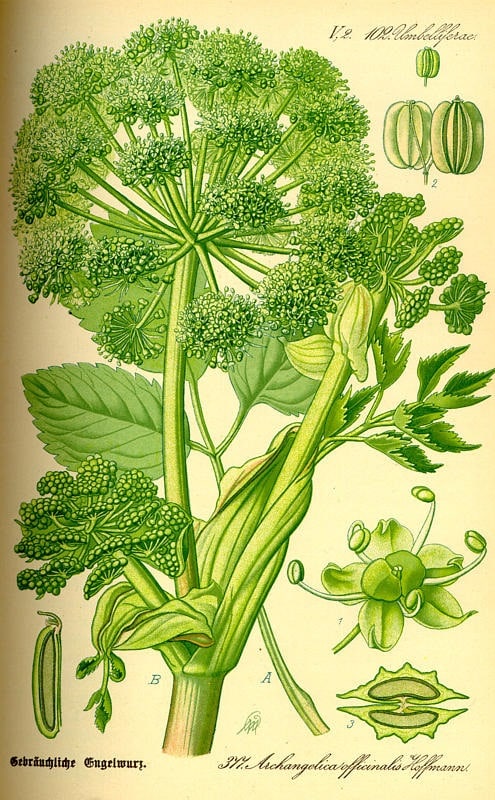Description of angelica root:
Angelica archangelica L. Archangelica archangelica Apiaceae – celery family Angelica is a partly dicotyledonous and partly perennial plant. In the first year, the plant sprouts from seed and produces a large clump of leaves with a stalked stalk, with a root resembling parsley and growing to about 4 cm thick. In the second year it flowers, and after flowering the thick root either survives partially or dies and develops from the base of the plant several fingers of thick, white, branched lateral roots. The outside of the root is yellowish-brown, while the inside contains yellowish-white and yellowish-coloured milky fluid. The stems are very strong, 130-230 cm tall, exceptionally growing to 4 m tall and up to 5 cm thick. In more northerly regions it grows much thicker. The stem is very branched, rounded, with a grooved surface, glabrous, tubular in shape, and hollow inside. The stem is often reddish-breathed and reddish spotted. The leaves grow enormously large. The bracts may be 30-50 cm long. The leaves are tomentose, the stem base forming a conspicuous large, inflated sheath into which the younger lateral shoots are enclosed. Leaf blade 2-3 closely winged, each segment ovate, with uneven and roughly toothed margins. The terminal leaf segment is three-lobed, the lateral ones often two-lobed. Leaves glabrous, dark green in colour, bluish-green veins. The upper leaves are gradually simplified until they become scabrous crumbs surrounding the inflorescence, on which the sheath is mainly developed and on top of which are 1-3 small leaflets. The top of the stem, as well as the lateral branches, is occupied by a large, spherical, rounded inflorescence, known as an umbel. The inflorescence forms a complex umbel with more than 30 branches, each of which has many pedicellate flowers at the end. The latter form the umbel. The umbel is hemispherical and surrounded by a collar of many small crumbly leaflets 5-10 mm long. The individual flowers are very small, yellowish-greenish-white and long-stalked. The angelica flowers in July and August. It has light brown, twin fruits.
Occurrence:
Angelica root is a rare plant and after much searching for its root, it is worth cultivating this plant. Angelica is a plant of the northern regions (Greenland, Iceland), where it grows in wet meadows, along the banks of rivers and streams, and in marshy ditches. In our country, it grows only in wetlands, notably in the wet places and along streams of the High Tatras (1906), mainly at the base of dwarf pines. Outside the county of Spiš, it is also found in Trenčín, Orava and Liptov counties, on the mountains of the Banat and in the rocky, watery places of the limestone hills of Transylvania, in Retyezat, Avrisel and Bucsecs. It is cultivated in gardens and is therefore also found wild in some places.
Drug:
Angelicae radix: dried root of medicinal angelica (Ph.Hg.VIII. min. 2 ml/kg essential oil) Angelicae radix, rootstock greyish or reddish brown, transversely ringed at the base, branching roots arise – cylindrical, longitudinally grooved at the rootstock apex sometimes with stem-leaf remnants (admissible foreign matter content: leaf-stem base: max 5%, faded plant parts: max 5 %, other foreign matter: max 1 %), fracture on uneven cross-sectional surface: – greyish-white, spongy, radially structured bark, in which the excretory ducts appear as brown patches – woody part of the bark ranging from light to greyish-yellow, surrounding the intestinal tissue, its volatile oil is distilled from the powdered root for 4 hours.
Medicinal properties and uses of angelica root:
It has been used in medicine since ancient times, especially by northern peoples. Cultivated angelica consists of a short main root, 5 cm thick, and a large number of densely branched secondary roots, 30 cm long and 1 cm thick at the base; the wild variety has a thicker and less branched root. The main mass of the angelica that is traded is the stipules. Angelica root has a strong, succulent, pleasant, pungent odour reminiscent of parsnips and a sweet, then pungent, pungent, bitterish taste. This is due to the specific essential oil it contains. Angelica root has been used against all kinds of ailments caused by weakness. It is also used to make tea, brandy and stomach-strengthening liqueurs; for example, it is the main ingredient in the so-called >englischbitter< brandy. Angelica root is also used in veterinary medicine. The young, tender stems and leaves are prepared as a stew by the northern peoples, the weak stems are boiled in sugar and used as a stomachic and digestive aid. In its traditional use, it was consumed more for digestive complaints.
Active ingredient of angelica root:
- 0.2-1.9% essential oil (alpha/beta fellandrene, alpha-pinene)
- coumarins, furanocoumarins (bergaptene, angelicin) coumarin: causes photosensitivity – photosensitivity
- resin
- angelic acid
- valeric acid
- malic acid
- starch
- sugar
- fat
- tannic acid
- bitter substances.
Cultivation:
A medium-drained damp, deep-rooted biennial plant that prefers nutrient-rich, friable soil. It is grown by seed by seedling pre-growing in the months of June and July. Before sowing at home, it is advisable to put the seeds in the freezer for a few weeks, as they need to be exposed to cold temperatures, otherwise they will have difficulty germinating. Once the seedlings are fully developed, they can be planted out in the autumn or early spring. The plant requires 60 cm of space. To plant a catastrophic acre, 350 grams of seed are needed. The yield of a catastrophic acre is 8 – 10 q (quintals) of roots. Most of the goods we have seen in trade have come from the Czech Republic.
Varieties:
- Budakalászi (1959)
Fertilization:
- Pre-sowing: organic manure in autumn soil preparation: N: 50-70 kg/ha P2O5: 80-100 kg/ha K2O: 120-180 kg/ha
Propagation:
- In the past, also with seedlings, but too DRY, by sowing in situ under winter, in November: 1-1.5 cm deep, 60 cm row spacing 8 kg/ha seed required in March: 1-1.5 cm deep, 60 cm row spacing 10 kg/ha seed required. If sown in March, seeds should be frozen for 2-3 weeks before sowing
Plant protection:
- Fusicladiolus scab is a withered spotting on the leaf surface, aphids spread viruses
Care:
- Pruning row spacing, watering in drought conditions (+150-200ml) Removal of flower stalks appearing in the 1st year
Harvesting:
- 1. or 2nd year, in October with a plough without a steering plate, coumarins (cause photosensitivity) -> plant protection gloves!!!
Yield:
- 1,6-1,8 t/ha – dry root yield
Processing:
Primary processing, root cleaning, removal of soil residues, other plant parts by washing, roots cut in 2-4 halves, then drying: 40-50 °C
Harvesting:
In most places, angelica root is dug in autumn. However, it is also possible to dig the angelica root in the spring of the second year, before it has greened up. The dug up angelica root is usually washed and then the lateral roots of the stronger specimens are braided into a bundle and hung on twine to air dry in moderate heat. The dried angelica root is greyish brown to reddish brown in colour, irregularly longitudinally furrowed and wrinkled at the tip, easily cut like wax, with a smooth breaking surface. Dried angelica is easily attacked by insects and must be dried thoroughly and transported quickly. When transported, it can be bagged. 5 kg of raw root will yield 1 kg of dry root. Not to be confused with wild angelica(angelica silvestris l.) which occurs in wet meadows, woods and along streamsides. Its collection is not worthwhile, although it is also used by the people as a domestic herb.
Source: Dr. Ferenc Darvas and Dr Gyula Magyary-Kossa,Domestic herbs, their production, marketing, effects and medicinal uses Béla Páter, Wild medicinal plants, their production, use and distribution

